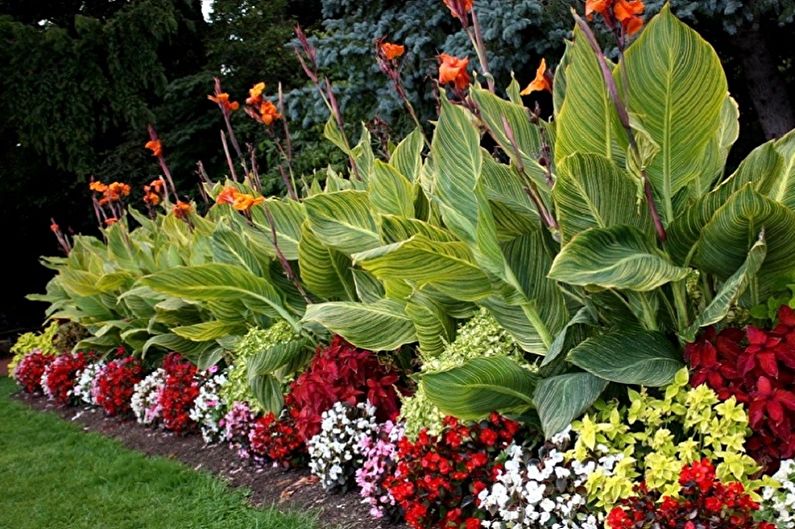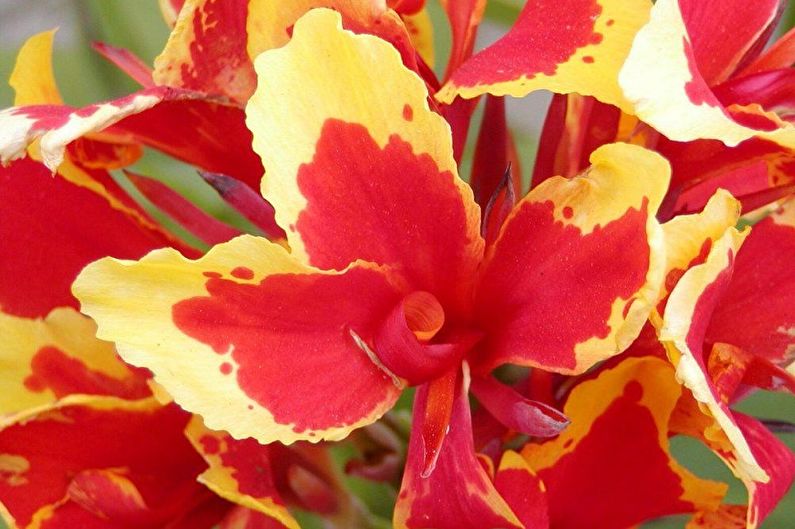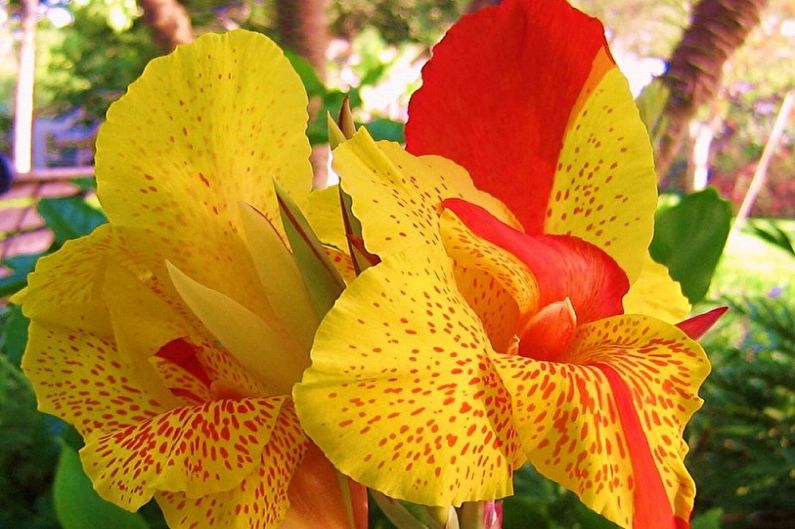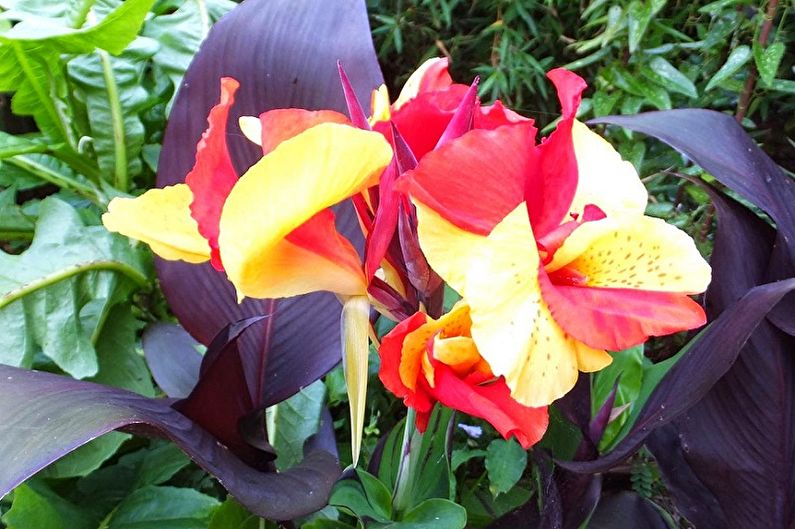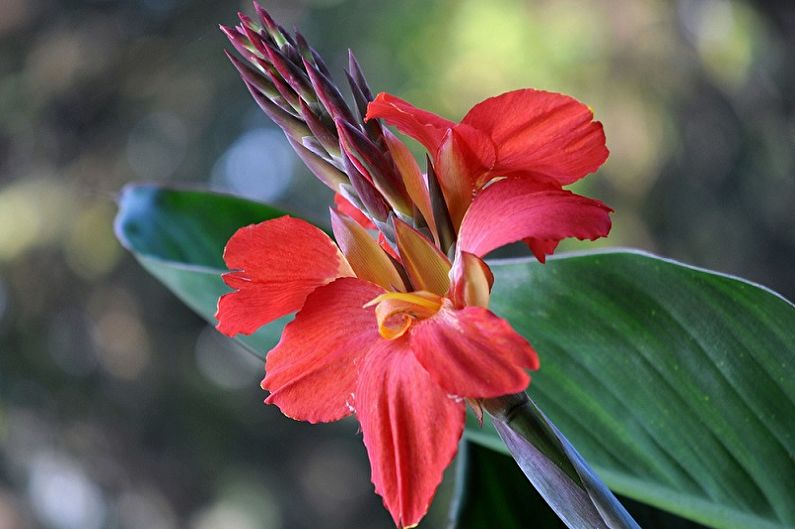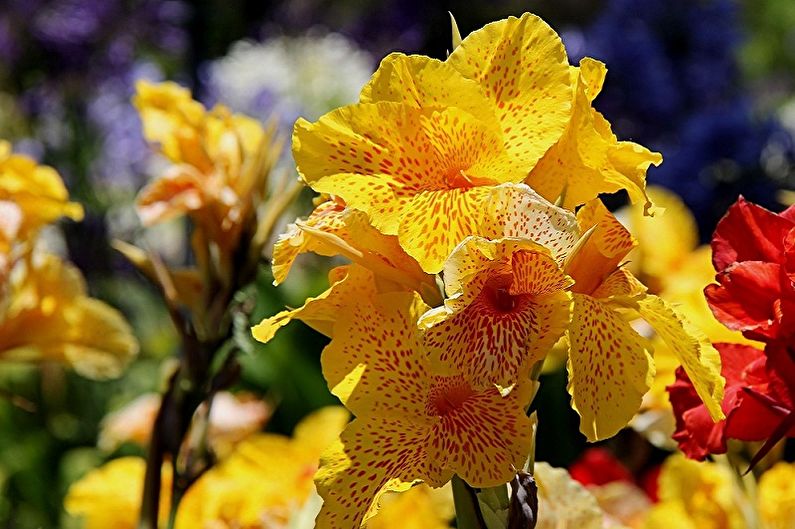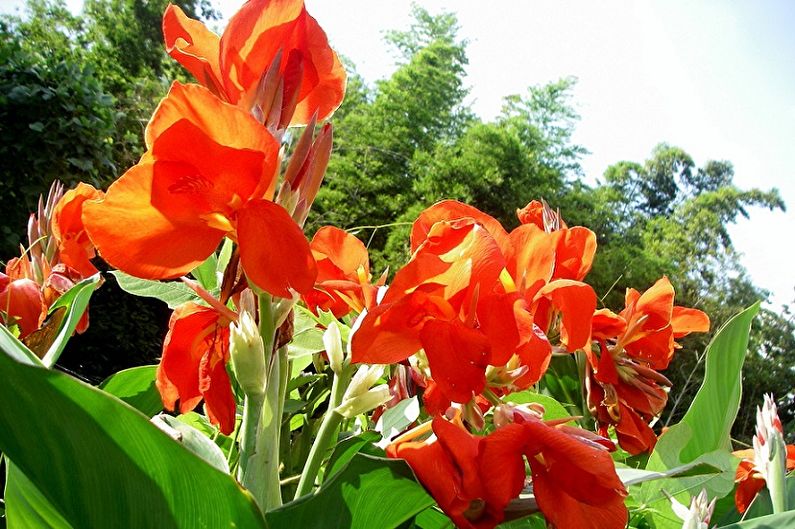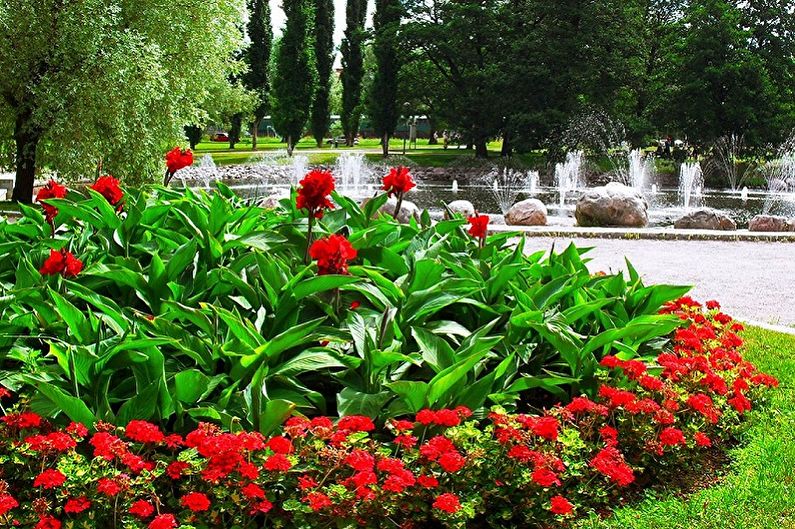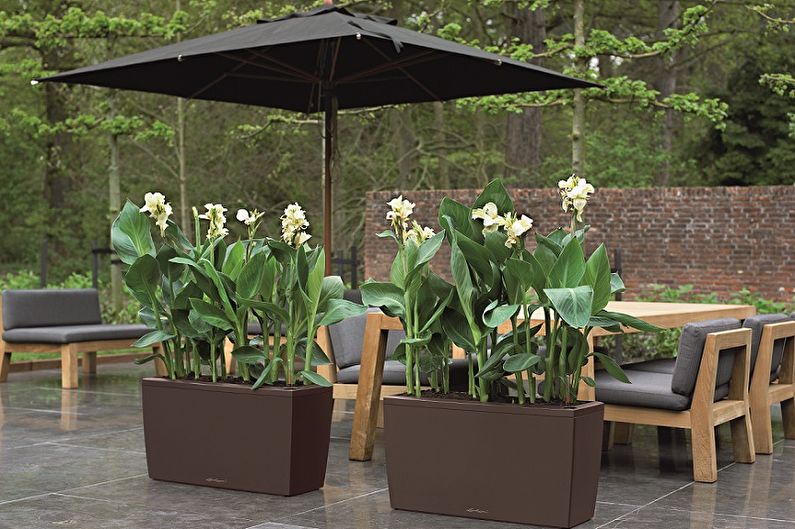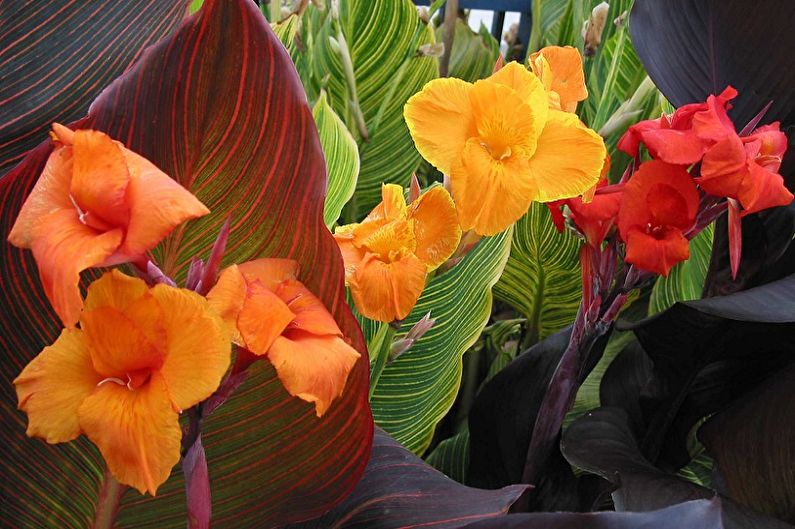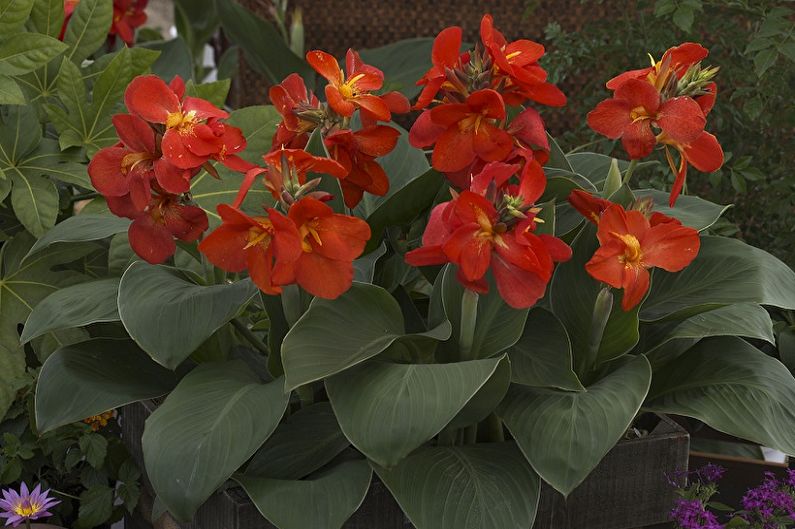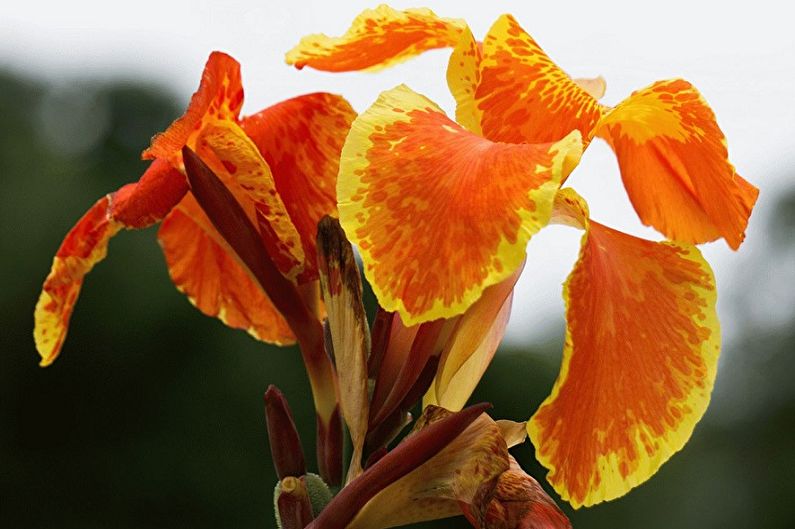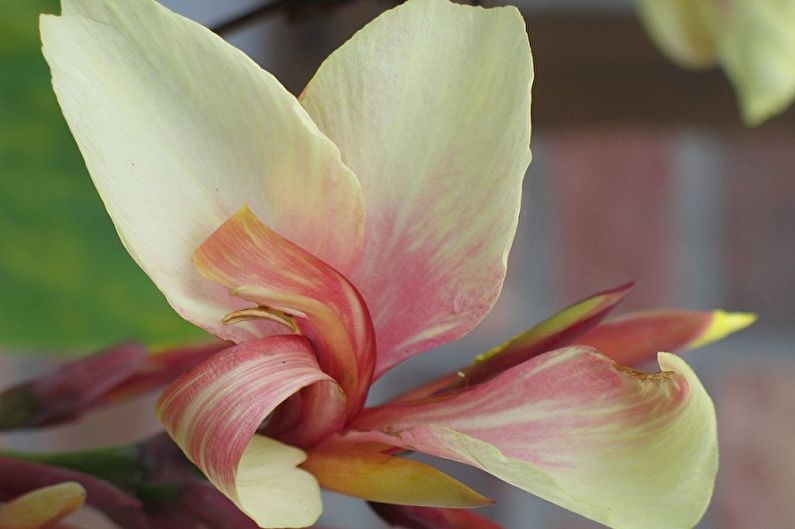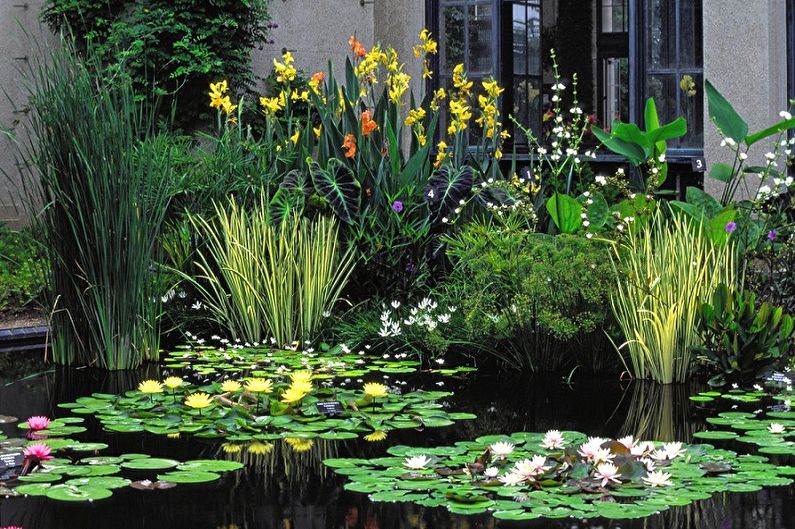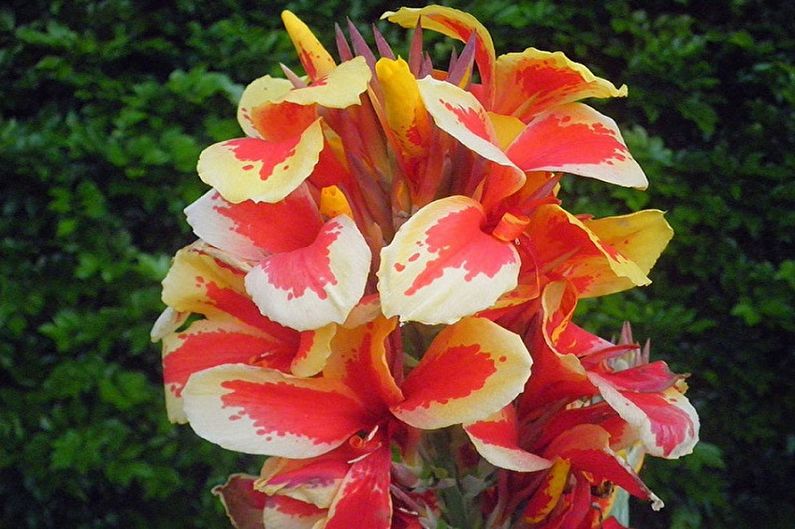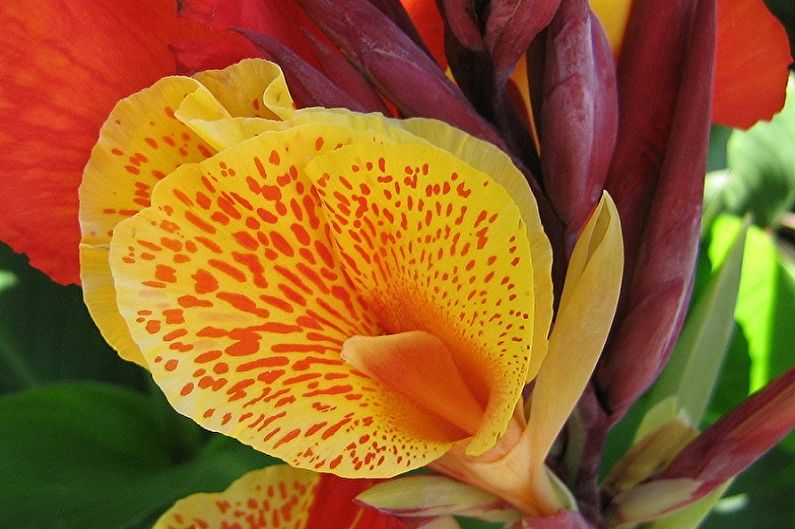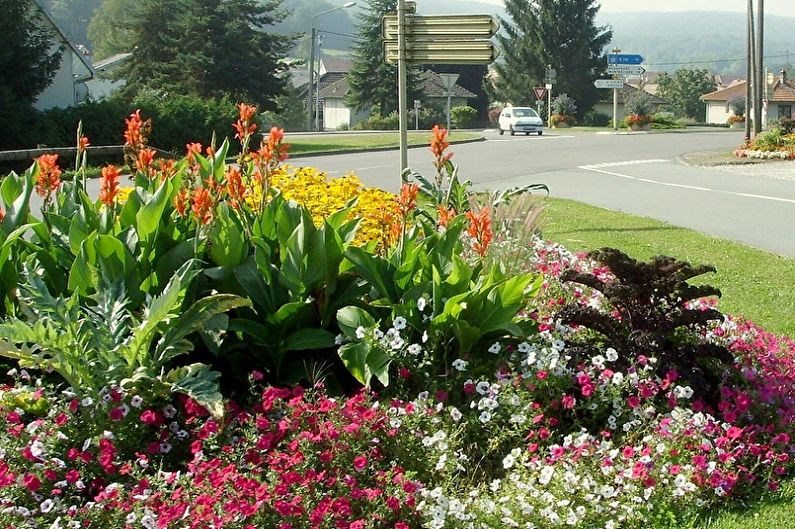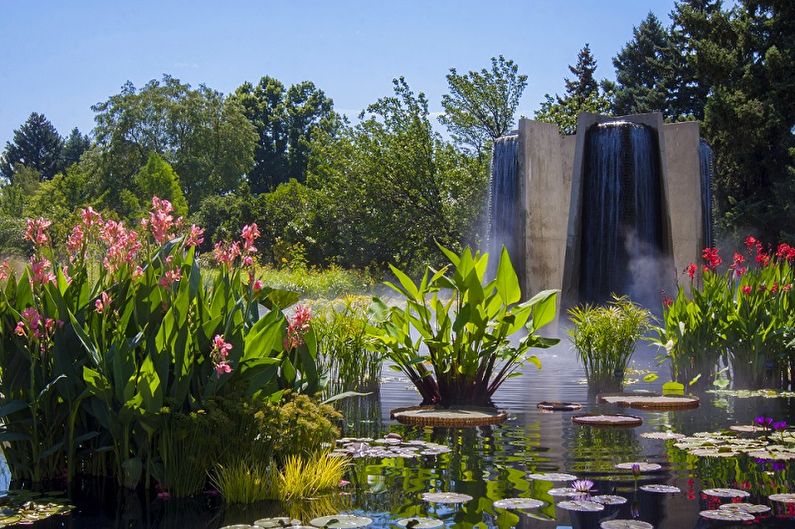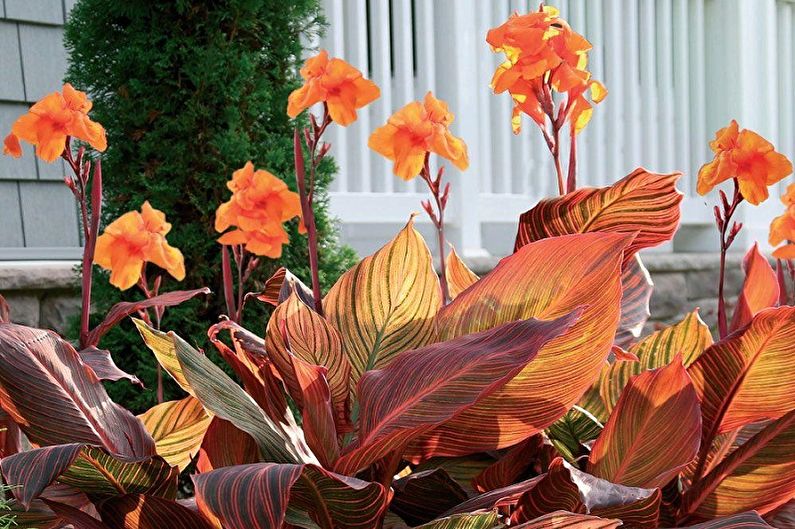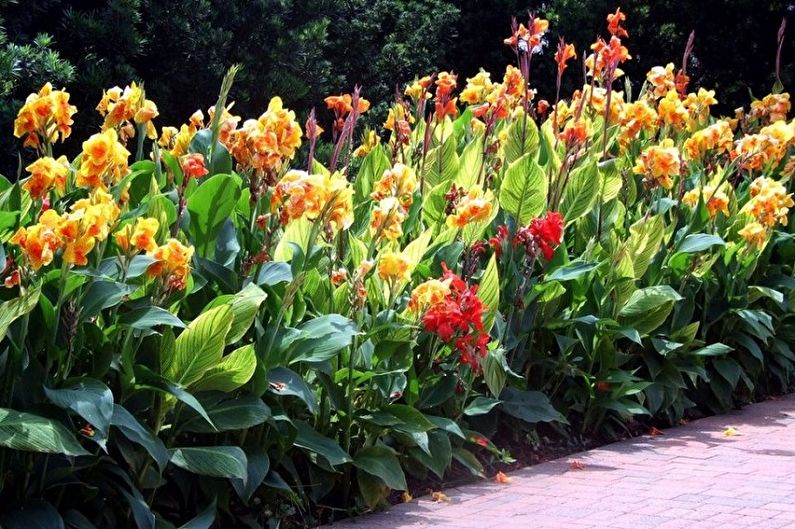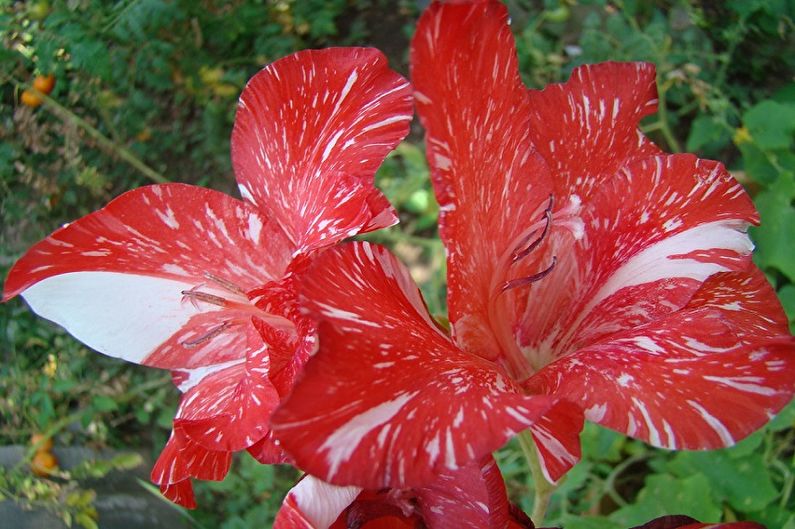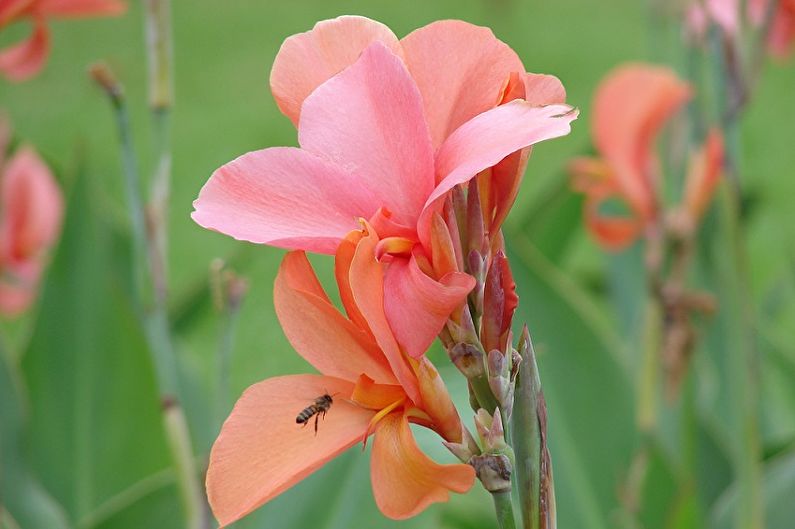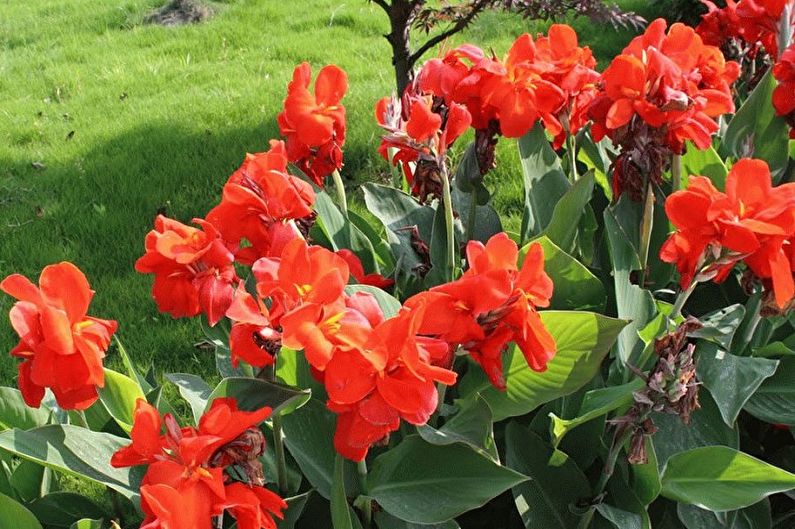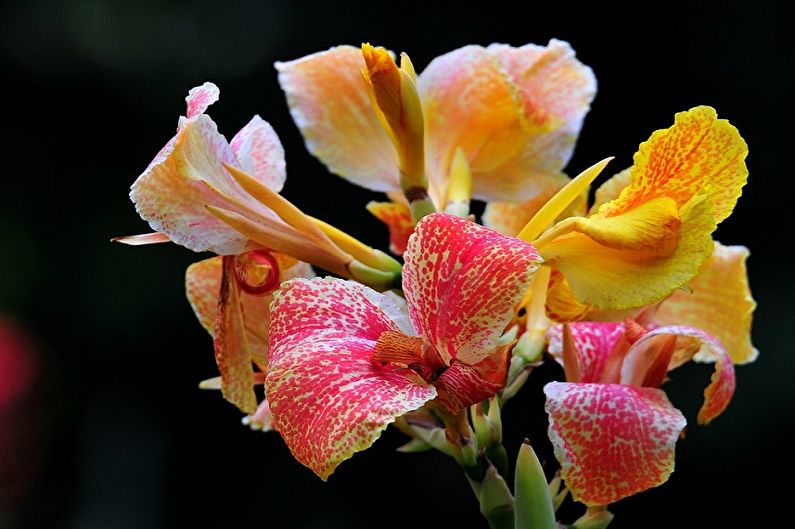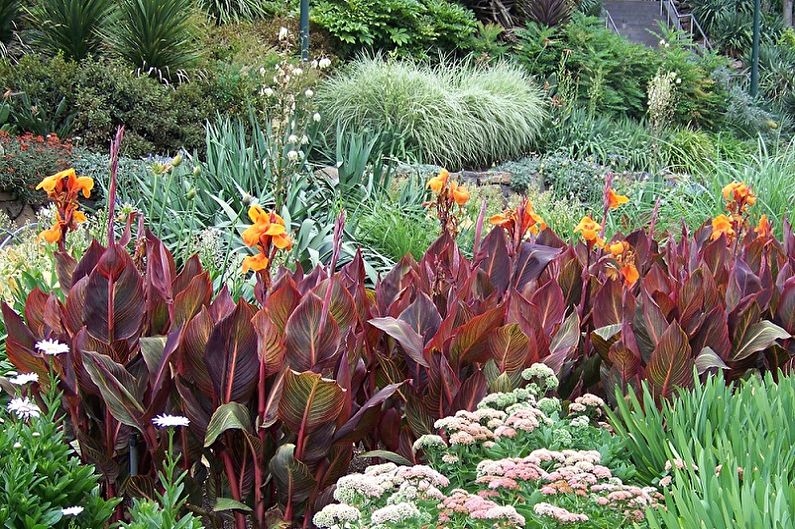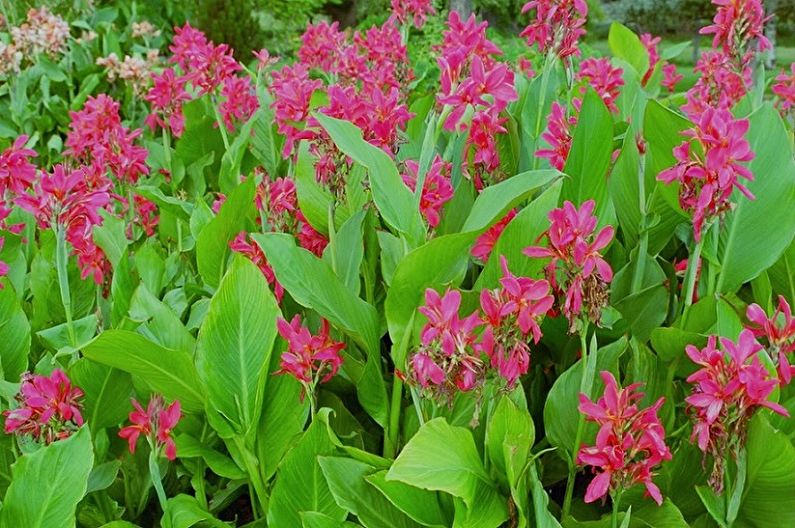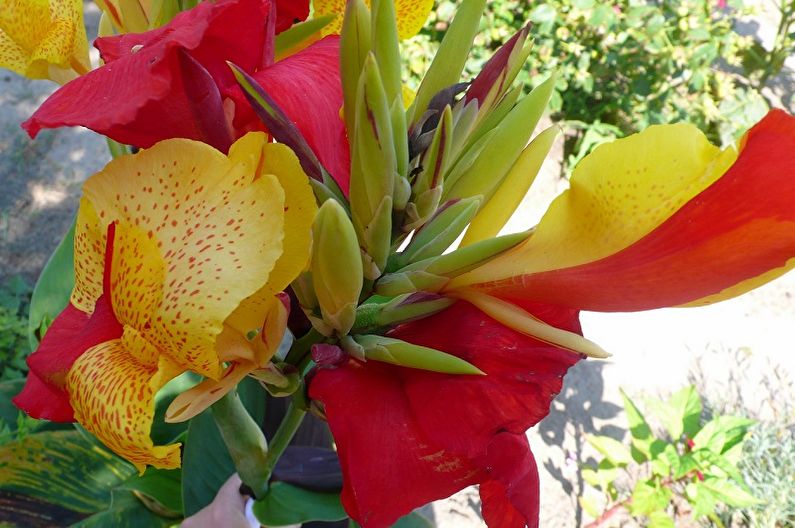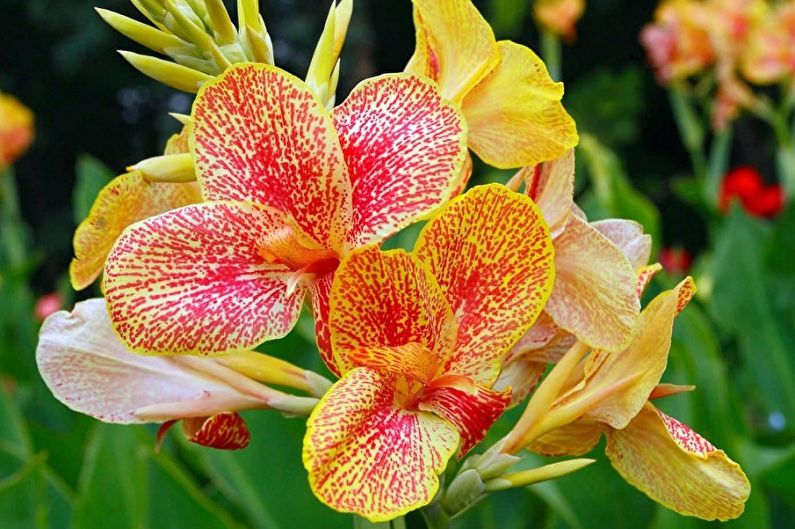
Canna is a unique ornamental plant that even before flowering looks luxurious due to the original color of large glossy leaves. Reaching 80 cm in length, they have a rich palette of shades, ranging from green to purple. An even greater variety of colors is characterized by asymmetric flowers, similar at the same time to exotic orchids and proud gladioli. White, pink, yellow, red, with a border or multi-colored blotches - they all look equally impressive both in group landings and single. Cannes are decorated with various varieties of beds, flower beds, mixborders, balconies and loggias, and large specimens are used to form hedges.
The main types
Today, about 50 types of crops and more than 1000 varieties are known. There are also quite a lot of classifications: varieties and species may differ in stem height, color of leaves, buds, flowering period, and other signs. We will consider the most popular types and varieties grown on personal plots and in apartments.
Canna garden
This name was not given to a single plant, but to a group of various large and small-flowered garden hybrids that are widely used in floriculture. Of particular popularity are such varieties as:
- "America" with purple flowers with a diameter of 12 cm, blooming in mid-summer;
- “President” - has large inflorescences up to 30 cm long, grows no more than 1 m;
- “Sunny Beauty” - with dense green foliage and yellow-cream luxurious flowers. Its height reaches 1 m;
- “Clara Buisson” - has beautiful orange flowers with speckled petals and purple leaves.
Also often found on garden plots are representatives of the German Titov variety, distinguished by purple-green leaves and pink flowers. Culture is capable of bearing fruit.
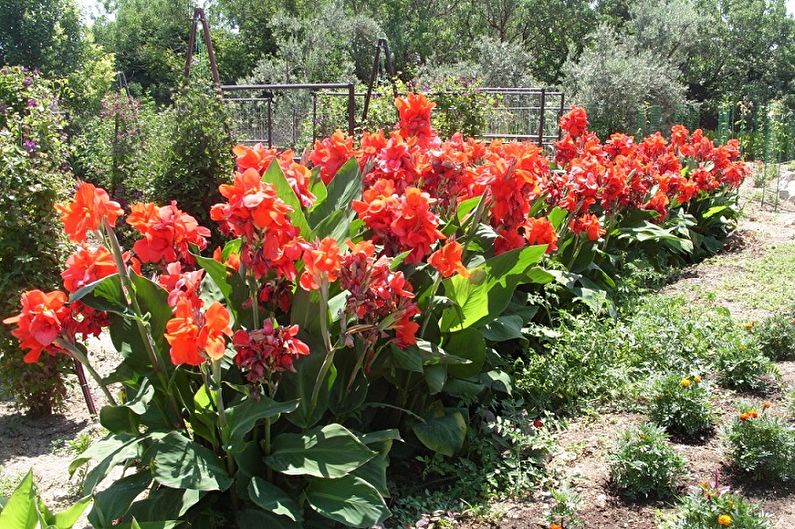
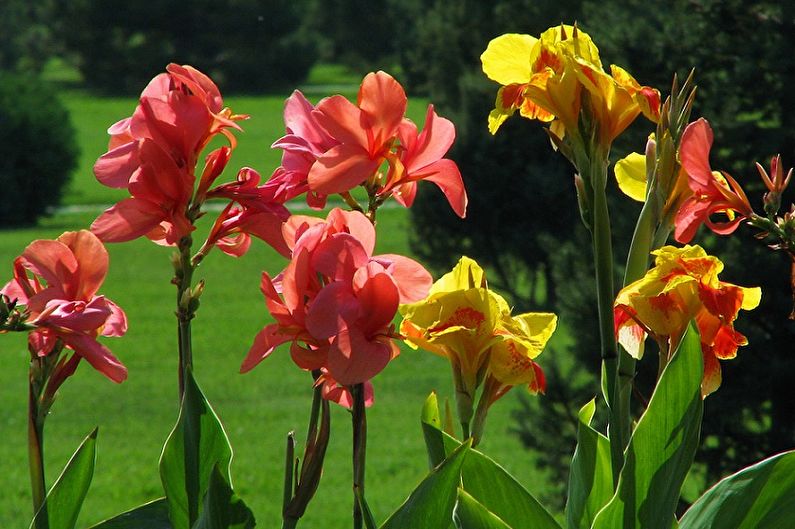
Kanna indian
The native land of this culture is western India, although it is also well distributed in central and southern America. The plant is quite tall - adult representatives reach two meters in height. The leaves are light green, sometimes with a red stripe. Flowers have pink and red hues, collected in brushes. This type of cannon has a long flowering period, which begins in June and lasts until late autumn.
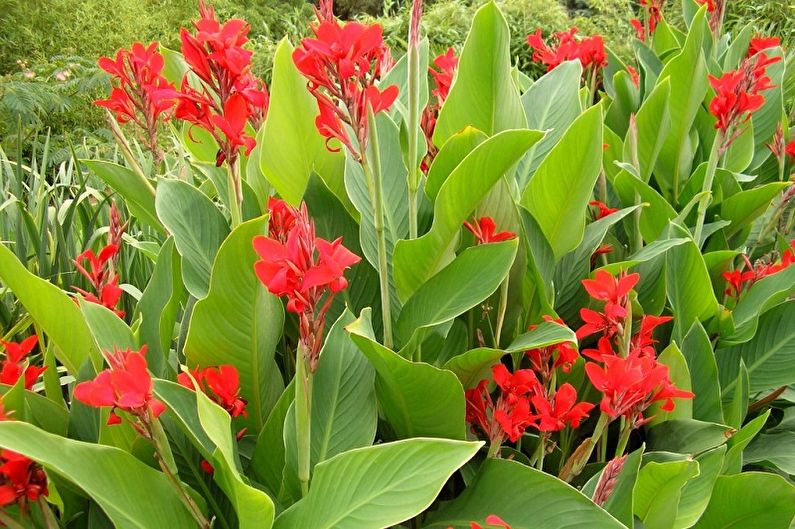
Kanna dangling
Its natural habitat is considered to be swamps and shallow waters of sea coasts. The species grows especially well on soils saturated with humus. It belongs to evergreens and reaches a height of 1.2 m. Its leaves are quite large - about 12 cm wide and up to 60 cm long. Compared to them, the flowers are much smaller and have a yellow-gray tint. The view is often used for landscaping, and is also planted around pools.
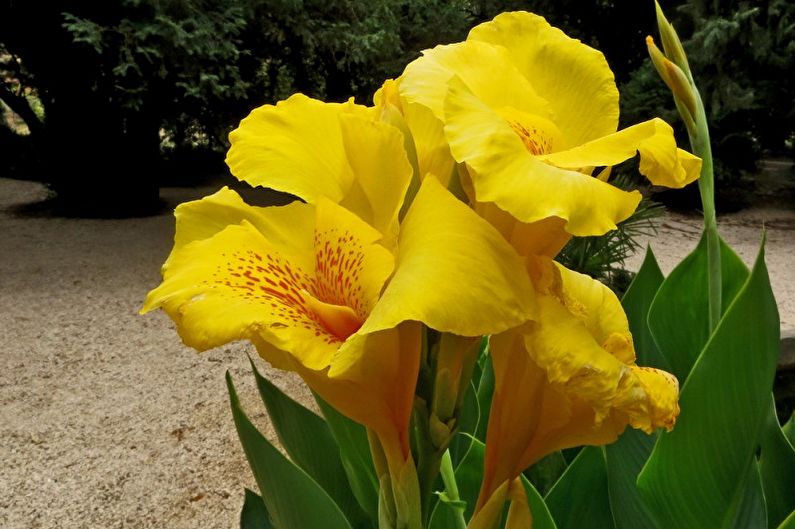
Canna low
This type of cannon has elongated half-meter oval leaves of bright green color. Red-orange flowers, up to 10 cm in diameter, are collected in neat inflorescences.
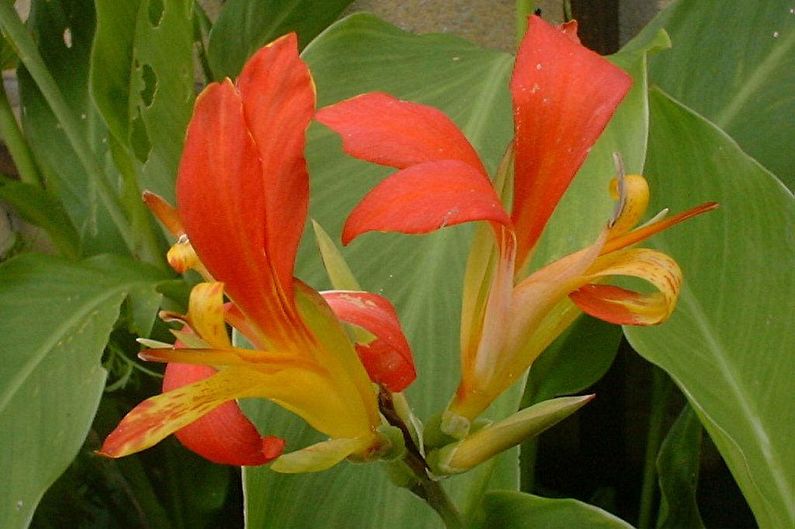
Kanna wyoming
A very original variety, the feature of which is to preserve the decorative bronze foliage throughout the season. Canna Wyoming has stems up to 1.5 m tall with bright orange flowers. The length of the inflorescences is 10-12 cm, flowering is quite long and plentiful.
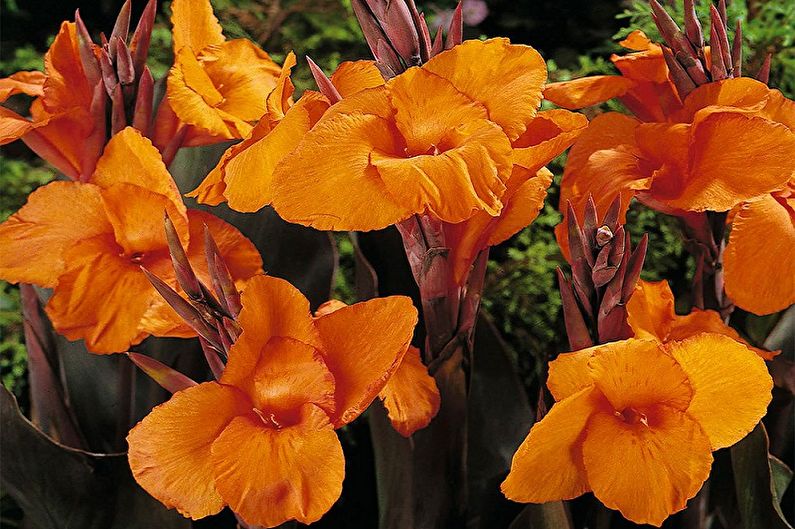
Canna confetti
The variety is medium in size, but it can boast of the beauty of its yellow-cream flowers with brownish and red spots. Such an original motley appearance of the buds fully explains the name of the culture.
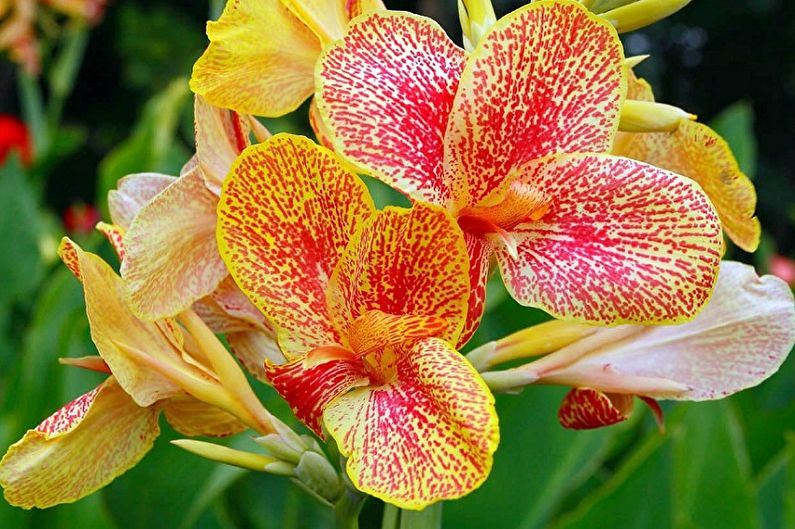
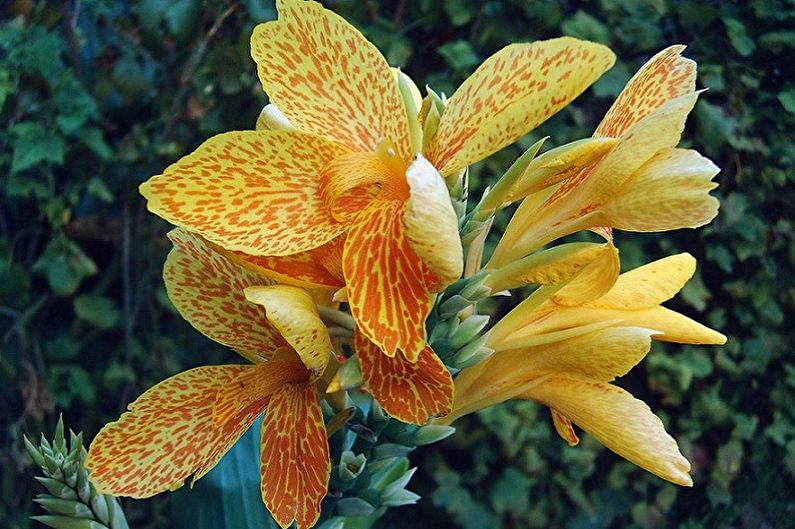
Canna Richard Wallace
The plant is able to grow up to 1 m.Very much appreciated by flower growers and landscape designers for attractive yellow flowers with red splashes and strokes, as if randomly scattered across the surface of the petals. The length of the inflorescences reaches 25 cm. The flowering period falls at the beginning of July.
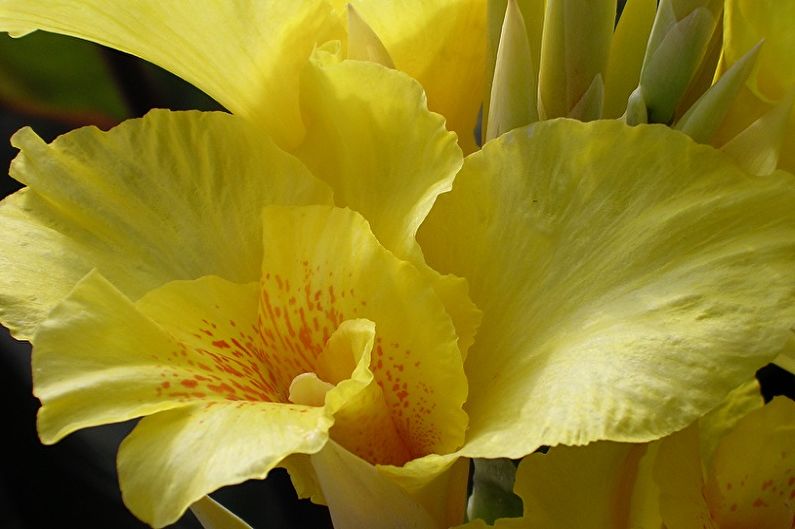
Proper cannabis care
Like any flowering plant, canna needs care. Health, life span and splendor of a flowering culture depend on how high-quality it will be.
Lighting
Gangnam residence is chosen in sunny areas, as the flower needs good lighting. In partial shade, the culture will also develop, especially grow actively, but flowering may become scarce or completely disappear. Young seedlings before planting in the open ground need to organize additional lighting.
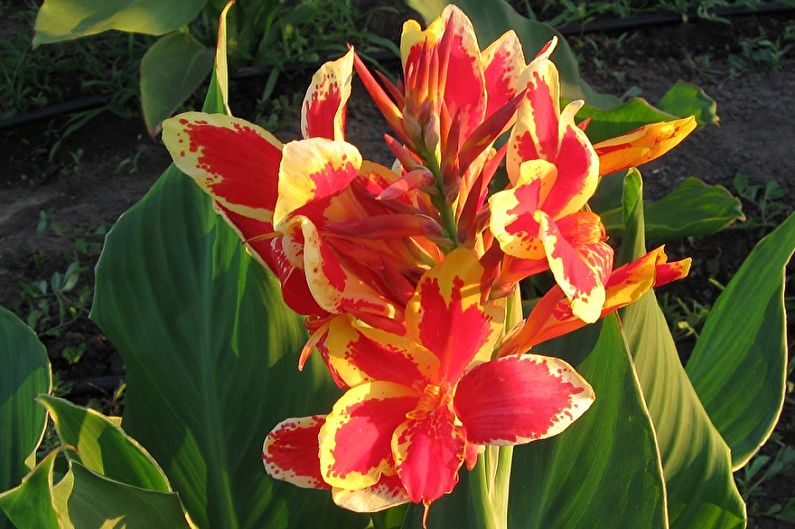
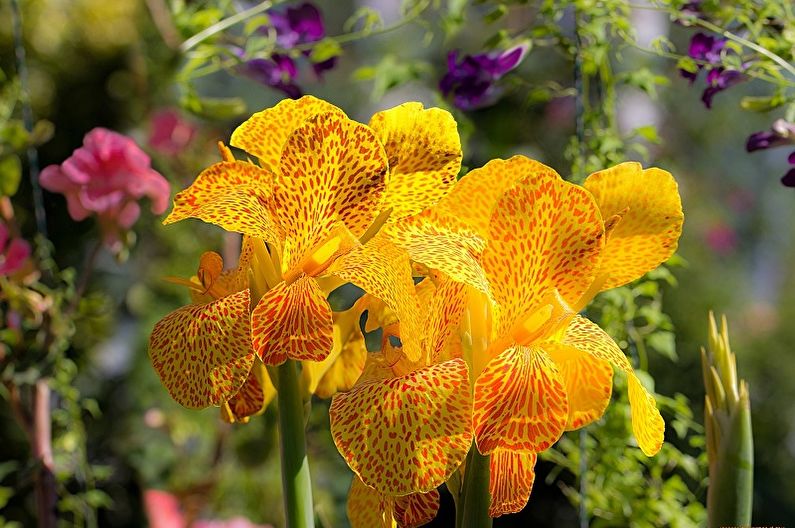
Temperature
Kanna feels great at medium temperature, so the range from +15 to + 18C will be optimal for her life. But during germination, when the first sprouts appear, it is better that the temperature is slightly higher, within the usual room temperature. An important point - Kanna loves coolness, but does not tolerate drafts that contribute to her illness.
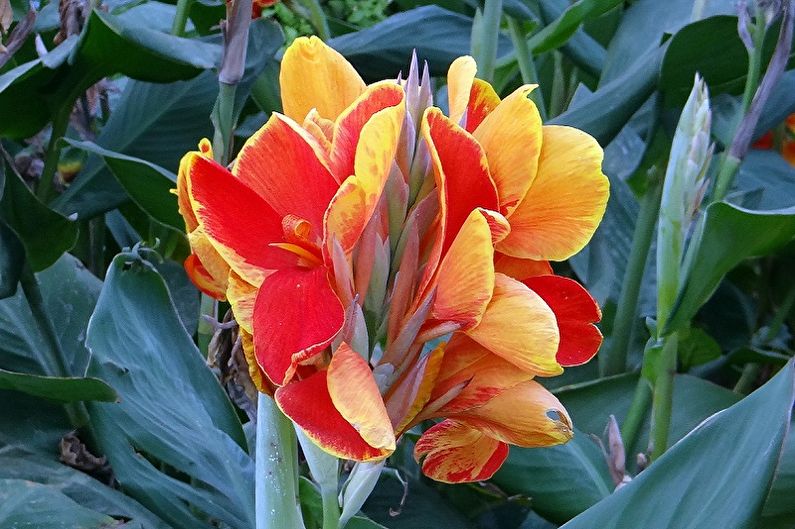
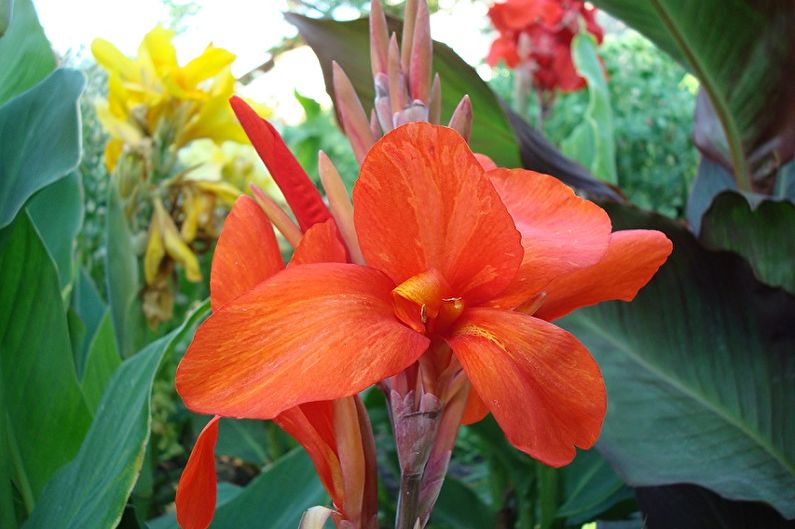
Humidity
The culture prefers moderate humidity, therefore, in the dry season, the canna should be sprayed, and wipe home vases with a damp cloth. If there is excess water after pouring into the glass pan, it must be poured out to avoid waterlogging of the soil. At the bottom of the pot or pit, it is necessary to arrange a drainage of sand or expanded clay. Drying of the soil should not be allowed, as intensive evaporation through wide leaves will begin. Some varieties prefer wetter soils near water bodies.
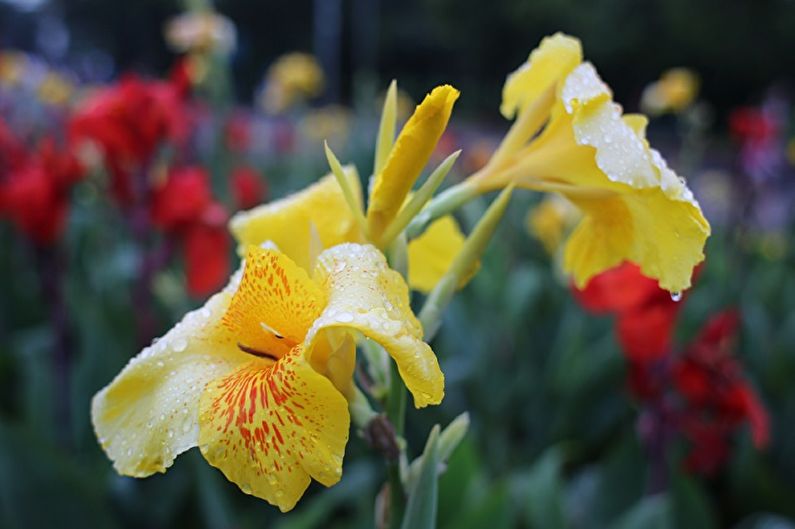
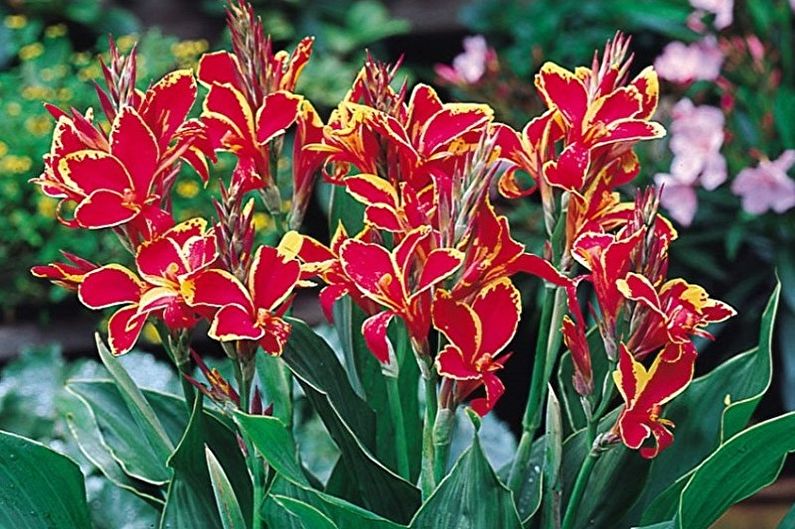
Watering
Kanna needs regular and moderate watering before shoots appear. A more plentiful drink is necessary for the plant during the flowering period, but it is important to prevent waterlogging and stagnation of water, which will lead to the development of fungal diseases of the rhizome. Indoor species are watered with settled water as necessary. To irrigate the canna in the garden, it is also better to use the settled heated water, which can be collected in a bucket in advance.
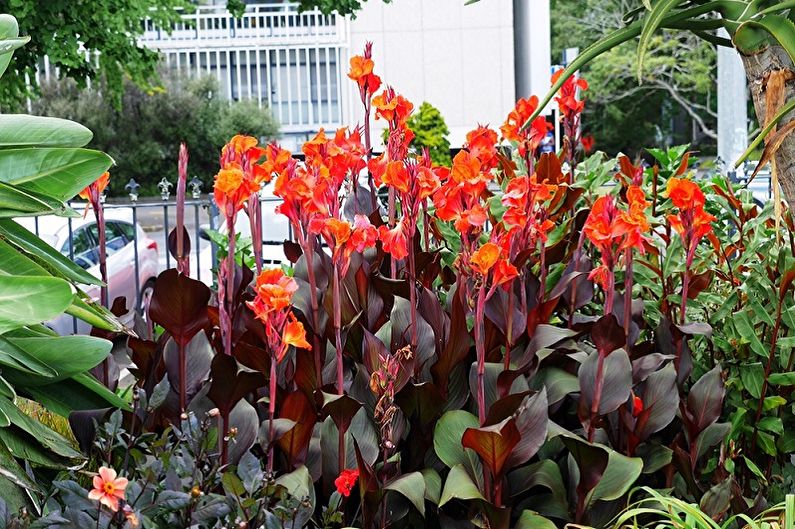
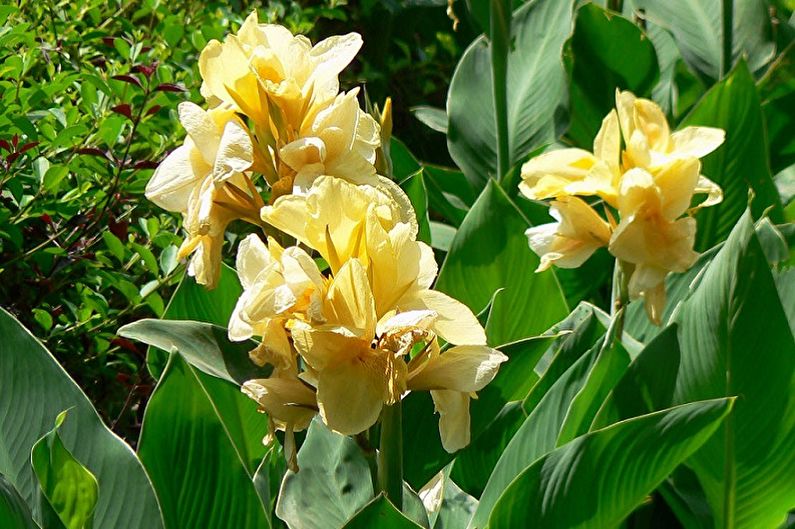
Fertilizers and fertilizing
Fertilizing and regularly nourishing the soil is necessary. For this, alternating organic and mineral compositions are used. As a rule, the first top dressing should be carried out with a nitrogen-containing composition, and the second with potassium phosphorus. Indoor plants are fertilized with complex dressings for indoor flowering plants.
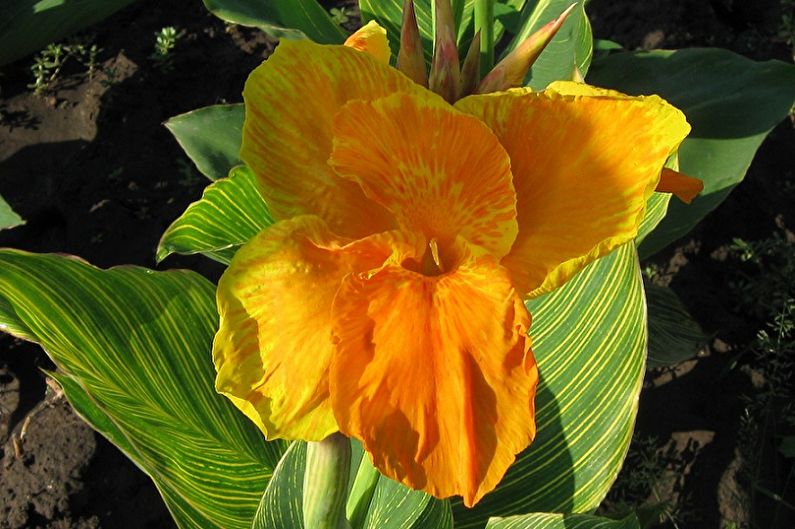
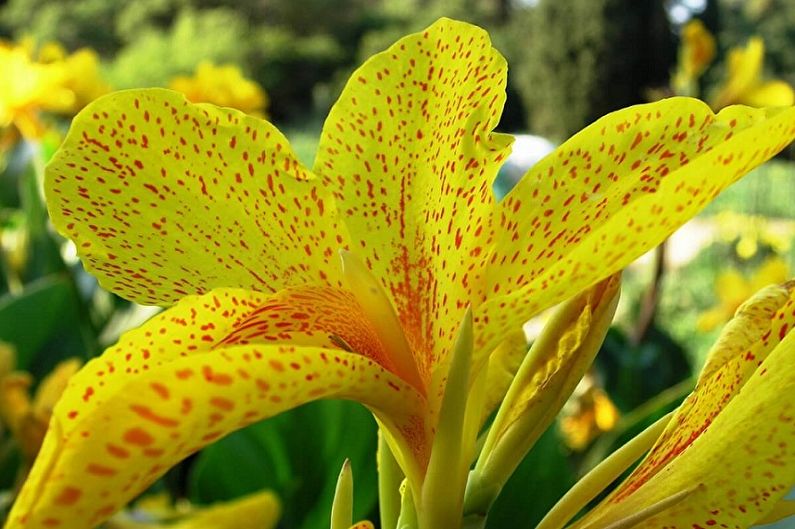
Pests and diseases
Kanna is resistant to diseases and pests, but certain dangers do occur. First of all, we are talking about fungal diseases, which most often cannot be cured, and the plant dies. At high humidity with a simultaneous decrease in temperature, a fungus can develop, provoking the disease "gray rot". Brown segments appear on the plant, which quickly become covered with spores that can transfer to neighboring crops. To avoid an ailment, it is necessary to follow the rules of care, planting, the timing and dose of nutritional supplements.
No less dangerous is the “rust mushroom”, which activates in highly waterlogged soil. At first, brown spots appear on the leaves of the canna, then the foliage completely dries and falls off. As a preventive measure, it is important to observe moderate watering.
The "cucumber mosaic" virus can be recognized by the threadlike patterns on the leaves. Infected foliage is able to secrete substances that attract pests, so the diseased plant must be removed immediately.
The threat to culture is not only ailments, but also pests, of which the following species are especially dangerous:
Aphid - chooses young shoots as a place of residence, eating their own juice. You can get rid of it with the help of sanitation with a soap solution;
Spider mite - causes great damage to the process of photosynthesis, it is also dangerous because it can transmit infections.Dry air contributes to its appearance, therefore it is necessary to increase atmospheric humidity, wash and spray the culture;
Scaffold - dangerous for its ability to produce a substance that provokes the development of a specific fungus (sooty). It settles on the backs of leaf plates. You can get rid of it by machining;
Nematodes - damage the roots of the canna. To preserve the culture, soil treatment with insecticides will be required.
The slugs that carry the infection do a lot of harm. Digging the soil and collecting weeds help to significantly reduce their numbers. You can also mulch the soil around the plant using pine needles, sawdust - this will create a reliable barrier.
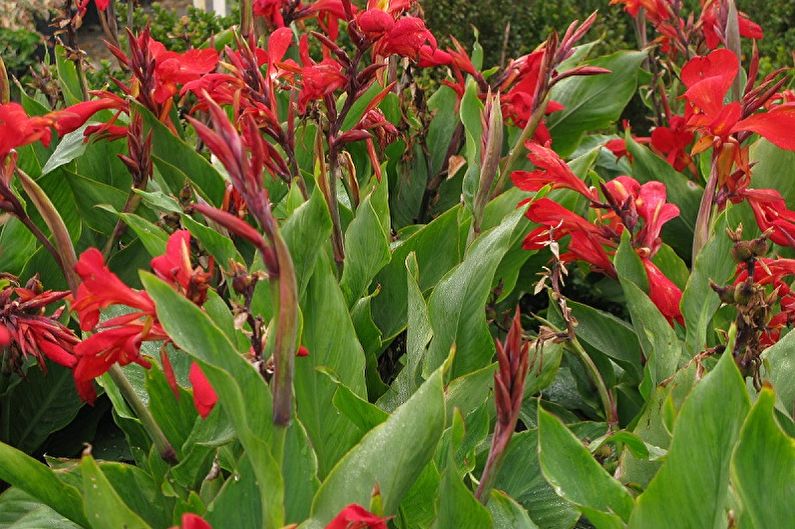
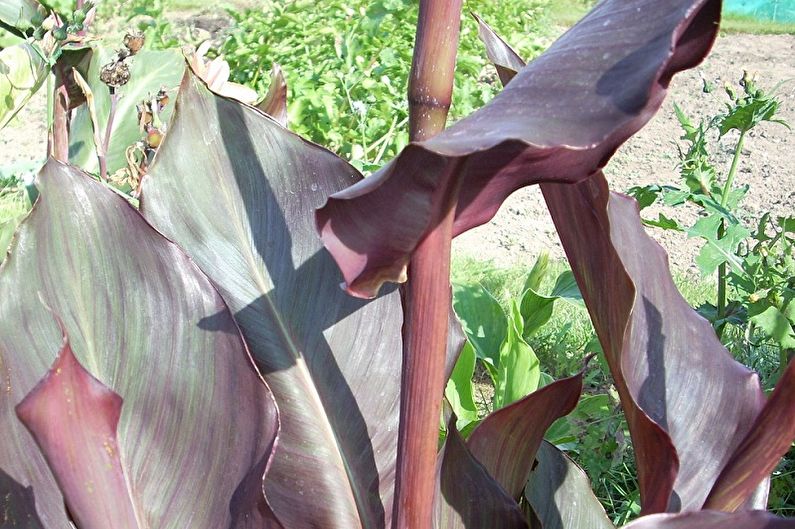
How to transplant a canna
Cannes are transplanted into the open ground in the second half of May, closer to summer, when the danger of frost disappears. Florists have one secret that allows them to achieve better adaptation of the plant and lush flowering: it is necessary to make a kind of “litter” from fresh manure.
To begin with, a rather deep pit from half a meter is dug, at the bottom of which a layer of manure of about 20 cm is laid, giving the roots heat. Then you need to pour a layer of soil of the same thickness and only then plant the canna. When planting, abundant watering is required. The bush is dug up at a depth of about 10 cm. It is important to observe the distance between the bushes and the beds - it should be at least 50 cm. The first flowering can be observed after one and a half to two months.
Sometimes the culture is transplanted in the fall, changing its habitat from the garden to the indoor flowerpot. In this case, before transplanting it into a spacious pot, with a diameter of half a meter, it is necessary to treat the ground with an insecticide to avoid getting garden pests.
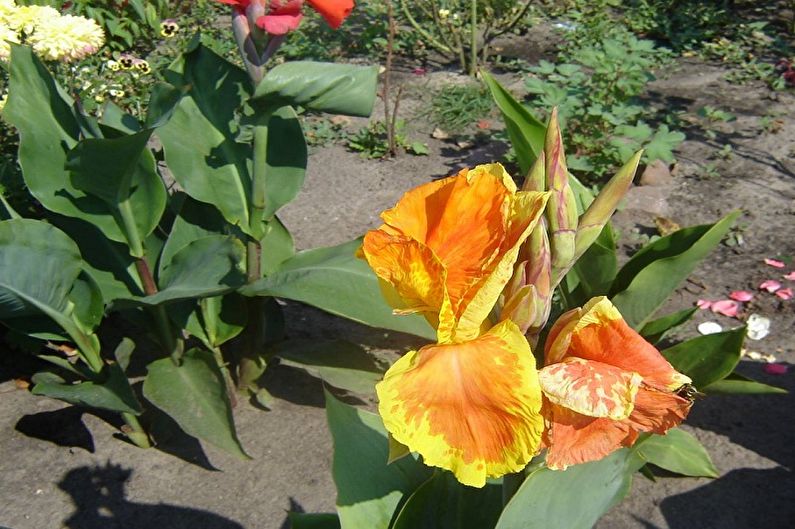

Propagation at home
You can grow a canna on your own in two ways - by sowing seeds or dividing an existing bush with a root. Growing seedlings from seeds carries some risk, since seedlings often give visible deviations from the original variety. If it is necessary to obtain a certain variety with an identical color palette, it is better to use the method of dividing the rhizome.
Propagation of canna seeds
Sowing canna seedlings begin in February. But this process is preceded by a mandatory “hard” seed treatment - they must first be kept a couple of hours in the cold, then doused with boiling water. Prepared seeds are deepened in a container with soil and placed in a bright, warm place. In a month you can expect the first shoots. At the end of March, the first dive is carried out in small pots, up to 15 cm in diameter. On the garden plot they can be placed in late spring, while choosing a plot that is closed from the wind and draft.

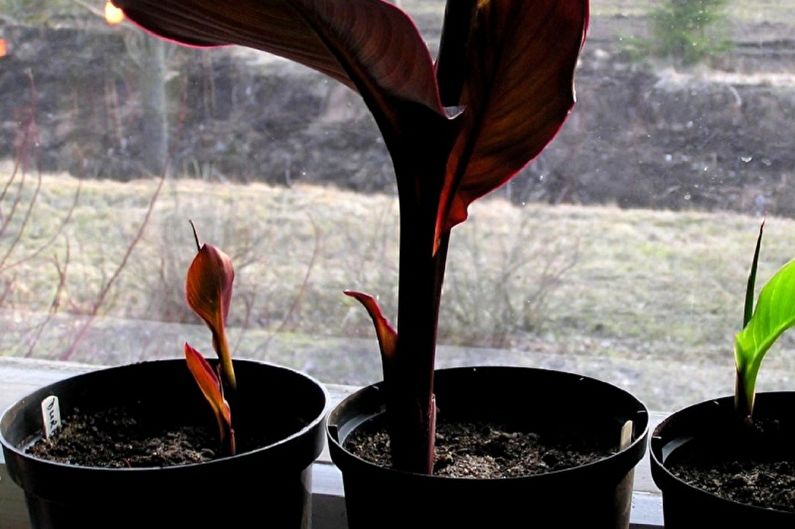
Canna propagation by rhizome division
This is a fairly simple and effective way to get new representatives of your favorite Cannes. In September, it is necessary to carefully remove the rhizome and transfer it to a cool room (cellar). At the end of March, the root is divided in such a way that each cut-off part has at least two buds. Slices must be treated with charcoal. The resulting blanks must be sent to the greenhouse, sprinkled with earth on top. With the advent of full-fledged leaves, bushes must first be placed in pots, and only in June can they be relocated to the ground.
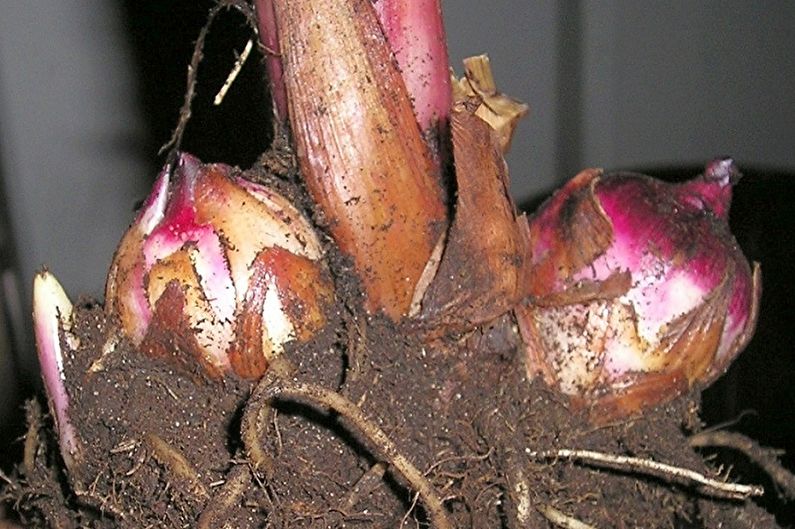
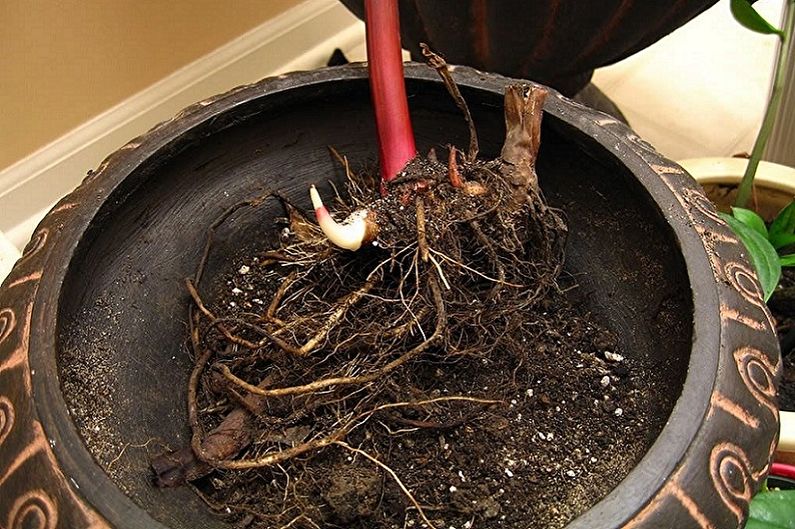
Canna - photo
Canna has been valued by florists for centuries and is widely used in landscape design. Its bright flowers against the backdrop of lush foliage give an elegant look to this plant, which, due to its decorativeness, can take pride of place in the center of any floral arrangement, become an adornment of the balcony, terrace, interior of the apartment. In our photo gallery you can get acquainted with various types of cannes, evaluate their graceful beauty and originality. Enjoy watching!
